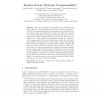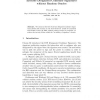68 search results - page 7 / 14 » Ring signatures without random oracles |
ASIACRYPT
2010
Springer
13 years 5 months ago
2010
Springer
This paper investigates the Random Oracle Model (ROM) feature known as programmability, which allows security reductions in the ROM to dynamically choose the range points of an ide...
PKC
2007
Springer
14 years 1 months ago
2007
Springer
Abstract. Key-insulated cryptography is a crucial technique for protecting private keys. To strengthen the security of key-insulated protocols, Hanaoka, Hanaoka and Imai recently i...
EUROCRYPT
1994
Springer
13 years 11 months ago
1994
Springer
Abstract. We construct the first O(1)-size designated confirmer signatures (DCS) with security in the state-of-the-art model of Camenisch and Michels, Eurocrypt 2000, without rando...
ICICS
2005
Springer
14 years 29 days ago
2005
Springer
The notion of concurrent signatures was recently introduced by Chen, Kudla and Paterson. In concurrent signature schemes, two entities can produce two signatures that are not bindi...
CISC
2008
Springer
13 years 9 months ago
2008
Springer
Anonymity is one of the main concerns in group-oriented cryptography. However, most efforts, for instance, group signatures and ring signatures, are only made to provide anonymity ...


